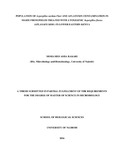| dc.description.abstract | Maize, the staple food for 96% of Kenya’s population is highly prone to aflatoxin contamination. The objective of this study was to understand shifts in baseline populations within Aspergillus section Flavi in soils and associated contamination of maize with aflatoxin as a result of application of atoxigenic A. flavus (Aflasafe KE01) in aflatoxin hotspot areas in lower eastern Kenya. The study was conducted during the short rains of 2013/2014 cropping season in four districts distributed across three Counties of lower Eastern Kenya which were worst hit by aflatoxicosis in 2004: Kathiani district (Machakos County), Nzambani district (Kitui County), Wote and Kaiti districts (Makueni County). Twenty four farms were randomly sampled in each district. A structured questionnaire was used to collect data on maize production practices. Soil samples were collected at the seventh leaf growth stage of maize, ground using a motor and pestle, sieved through a 2 mm mesh screen, sun dried for five days and stored at room temperature (23 ± 2° C) in Kraft bags until microbial analysis was undertaken. Aflasafe KE01 was applied when maize was at the seventh leaf growth stage by broadcasting at the rate of 10 kg/ha. Maize cobs were sampled at harvest, sun dried for seven days, shelled manually and oven dried at 45 oC for 48 hours. Moisture content (MC) of the maize grains was measured and samples that had >13% MC were oven dried again for 12 hours at 45 oC. Aspergillus section Flavi from soil and maize samples were isolated on modified rose Bengal agar. One gram of each ground maize and soil samples were dissolved in 10 ml of sterile distilled water and incubated for three days at 31 oC. Aspergillus species were identified on 5/2 agar based on cultural and morphological characteristics after incubation for five days at 31 oC. Aflatoxin level in maize samples was determined using the Enzyme Linked Immunosorbent Assay (ELISA) based Accuscan Pro-reader method. Aflatoxin produced by Aspergillus section Flavi isolates in vitro was measured by thin layer chromatography. Farmers in lower Eastern Kenya were mainly found to grow the local variety of maize and were intercropping it with pigeon peas. They were also found to use oxen plough to till their land and were applying manure as the main soil amendment. After harvesting the maize, the farmers were mostly found to store their maize in granaries. Four morphotypes of Aspergillus section Flavi were commonly isolated from the soil: A. flavus S-strain (56.9%), Aspergillus flavus L-strain (26.2%), A. parasiticus (13.6%) and A. tamarii (3.2%). The population of atoxigenic A. flavus L-strain was significantly (p ≤ 0.05) higher (84%) in maize samples from Aflasafe KE01 treated fields than the other members of Aspergillus section Flavi. On the other hand, the population of A. flavus S-strain was significantly (p ≤ 0.05) higher (62%) in samples from untreated maize fields. The mean aflatoxin level in maize grains from treated fields was 44.8ppb while in untreated fields the mean was 84.3ppb. Aflasafe KE01 reduced aflatoxin level in maize grains by 47% across the four districts. Aflatoxin B1, B2, G1 and G2 were detected in the isolates of Aspergillus section Flavi. Isolates of A. flavus S-strain produced the highest level of aflatoxin B1 (Mean = 3964ppb). Both A. flavus S-strain and A. parasiticus produced aflatoxin B1, B2, G1 and G2 while A. flavus L-strain only produced aflatoxin B1 and B2. Aflasafe KE01 is a promising biocontrol product in shifting the population of toxigenic strains of Aspergillus section Flavi and subsequently reducing aflatoxin levels in maize. | en_US |



